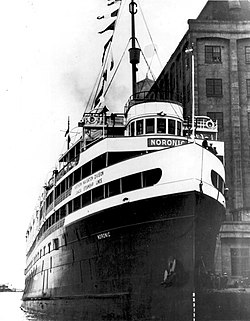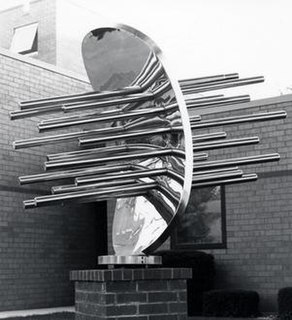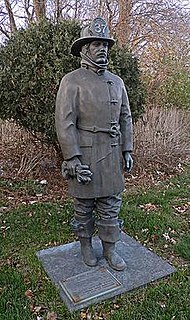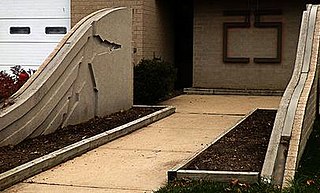
The first memorials to the victims of the September 11 attacks in 2001 began to take shape online, as hundreds of webmasters posted their own thoughts, links to the Red Cross and other rescue agencies, photos, and eyewitness accounts. Numerous online September 11 memorials began appearing a few hours after the attacks, although many of these memorials were only temporary. Around the world, U.S. embassies and consulates became makeshift memorials as people came out to pay their respects.

SS Noronic was a passenger ship that was destroyed by fire in Toronto Harbour in September 1949 with the loss of at least 118 lives.
This is a glossary of firefighting equipment.
The New Zealand Fire Service was New Zealand's main firefighting body from 1 April 1976 until 1 July 2017 - at which point it was dissolved and incorporated into the new Fire and Emergency New Zealand.

Bunker gear or turnout gear, also known as a fire kit in the UK and Ireland, are terms used by many firefighters to refer to their Personal Protective Equipment or PPE. "Bunker gear" and "turnout gear" can refer, depending on the context, to just the trousers, boots and jacket, or to the entire combination of personal protective equipment and personal protective clothing. The terms are derived from the fact that the trousers and boots are traditionally kept by the firefighter's bunk at the fire station to be readily available for use. In Hong Kong, it is referred to as "incident gear".

Warwickshire Fire and Rescue Service is the statutory fire and rescue service serving the county of Warwickshire in the West Midlands region of England.
The Firefighter Combat Challenge is the only federally funded, university-based occupational health physiological research study that has become an internationally touring and televised sports event. It’s a demanding 5-event physical challenge that firefighters throughout the world participate in and try to complete with the fastest time. Competition events include a stair climb with a high-rise pack, hose hoist, forcible entry, hose advance, and a victim rescue. The primary purpose for the Firefighter Combat Challenge is to promote physical fitness, an essential part of structural firefighting.
The Charleston Sofa Super Store fire occurred on the evening of June 18, 2007, in Charleston, South Carolina and killed nine firefighters. This was the deadliest firefighter disaster in the US since the September 11 attacks. The fire was believed to have started in some discarded furniture in the loading dock area, and though the source of ignition has been left undetermined, there is reason to believe it may have been a discarded cigarette.

One Meridian Plaza was a 38-story high-rise office building in Philadelphia, Pennsylvania, United States. The 492 feet (150 m) tower was designed by Vincent Kling & Associates and completed in 1972. The building was demolished in 1999, as a result of damage of a fire that began on February 23, 1991. The fire began on the 22nd floor and raged out of control for hours. An investigation of the fire, led by the Office of the Fire Marshall of the City of Philadelphia with assistance from the Bureau of Alcohol, Tobacco, Firearms and Explosives' (ATF) national investigative response team, determined the blaze started after linseed oil–soaked rags ignited. Philadelphia firefighters fought the blaze, but struggled due to a lack of power in the skyscraper and insufficient water pressure from the building's standpipes. Three firefighters died in the twelve-alarm fire after becoming disoriented by heavy smoke. Firefighting efforts inside One Meridian Plaza eventually were abandoned, due to fears the structure would collapse. The fire was only brought under control once it reached the 30th floor, which was one of the few floors that had automatic sprinklers installed. Ten sprinklers held back the fire until it started burning itself out and was finally brought under control almost a full day after it started. The blaze seriously damaged the building, destroying eight floors and damaging neighboring buildings.
A muster is an event pertaining to fire/rescue services. It is held in a central area such as a park and has many activities for fire department members and sometimes other community members. A muster typically revolves around a firematic competition between fire companies from around the surrounding area. Other attractions include a flea market, live music, food, demonstrations, apparatus judging, vehicle shows and contests.

The Honour medal for firefighters is a state decoration of France bestowed by the Ministry of the Interior to members of the French Fire Service.

Deflected Jets is a public artwork by American artist Guido Peter Brink located on the Fire Engine Company #29 grounds, which is at 3529 South 84th Street in Milwaukee, Wisconsin in the United States. Commissioned in 1987 and installed the following year, the work consists of a stainless steel abstract form atop a red brick base, to which a placard is affixed. The total size of the piece is approximately 136 by 35 by 35 inches.

Spirit of the Firefighter is a public art work by American artist Mark Jeffries, located on the north side of Milwaukee, Wisconsin. The bronze sculpture depicts a male figure wearing a firefighter's protective uniform: cuffed boots with trousers tucked inside, a long belted coat with toggle closures on the front, and a close-fitting hood. On top of his head is a brinned hat with an "Engine 37 MFD" badge on the front. The figure's arms and hands are at his side. In one hand, he holds his two gloves. The sculpture is installed at 5335 W. Teutonia Ave. at Milwaukee Fire Department Engine Company #37.

The Dauntless Guardian is a public art work by American artist Jeune Nowak Wussow, located on the northwest side of Milwaukee, Wisconsin. The bronze figurative sculpture depicts a child being rescued by a firefighter. It is located at 4141 West Mill Road at Milwaukee Fire Department Engine Company #9.

Fire and Water is a public art work by American artist John Luttropp, located on the southwest side of Milwaukee, Wisconsin. The multi-element architectural sculpture was created for the entrance of the Milwaukee Fire Department Engine Company #25 station. It is located at 300 S. 84th St.
Ribbons VI is a public art work by artist Stephen Fischer. It was installed in the Menomonee Valley in downtown Milwaukee, Wisconsin in 1989.
The Last Alarm is a public art work by artist Robert Daus. It is located in front of the Milwaukee Fire Department headquarters in downtown Milwaukee, Wisconsin at 7th and Wells Streets.














